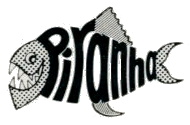
Rick Dangerous is a platform game developed by Core Design for the Acorn Archimedes, Amiga, Atari ST, Amstrad CPC, ZX Spectrum, Commodore 64, and MS-DOS. The game was released in 1989 and published by MicroProse on the Firebird Software label in the UK, and on the MicroPlay label in America. It was also published in Spain by Erbe Software. Later, it was released with two other games, Stunt Car Racer and MicroProse Soccer, on the Commodore 64 Powerplay 64 cartridge. The game was followed by a sequel, Rick Dangerous 2, in 1990. Loosely based on the Indiana Jones film franchise, the game received mixed reviews from critics.
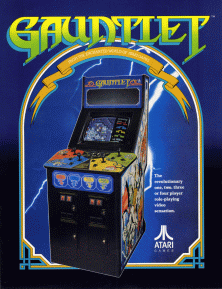
Gauntlet is a 1985 fantasy-themed hack-and-slash arcade game developed and released by Atari Games. It is noted as being one of the first multiplayer dungeon crawl arcade games. The core design of Gauntlet comes from 1983 Atari 8-bit dungeon crawl game Dandy, which resulted in a threat of legal action. It also bears striking similarities to the action-adventure maze game Time Bandit (1983).
Gargoyle Games was a British software company founded in 1983 by Roy Carter and Greg Follis in order to publish their first game, Ad Astra. They generally specialized in games for the ZX Spectrum even though the company was originally named with the intention of publishing games for Dragon computers. They later created a new label specifically for arcade-style games, Faster Than Light (FTL), as well developing titles for Elite Systems.

Head Over Heels is an action-adventure video game released by Ocean Software in 1987 for several 8-bit home computers. It uses an isometric engine that is similar to the Filmation technique first developed by Ultimate Play the Game.

Lenslok is a copy protection mechanism found in some computer games and other software on the 8-bit Atari computers, Commodore 64, Sinclair ZX Spectrum, Sinclair QL, MSX and Amstrad CPC. The first game to use it was Elite for the ZX Spectrum.
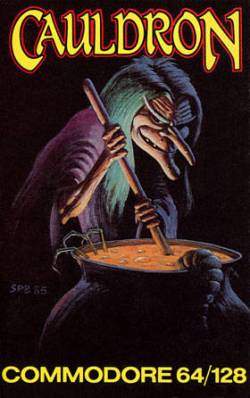
Cauldron is a shoot 'em up platform game developed and published by British developer Palace Software. The game was released in 1985 for the ZX Spectrum, Commodore 64 and Amstrad CPC home computers. Players control a witch, who aims to become the "Witch Queen" by defeating an enemy called the "Pumpking".
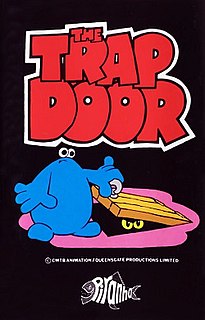
The Trap Door is a video game published for the ZX Spectrum in 1986 by Piranha Software and ported to the Amstrad CPC and Commodore 64 by Five Ways Software. It was written by Don Priestley and based on the British children's television show of the same name.
Quicksilva was a British games software publisher active during the early 1980s.
Crystal Computing, later renamed Design Design, was a British video game developer founded in 1982 by Chris Clarke and Ian Stamp while students at the University of Manchester. Graham Stafford, Neil Mottershead, Simon Brattel and Martin Horsley, joined the company as it expanded. The company's first software release was a compilation of games for the Sinclair ZX81, though it was with the ZX Spectrum that Crystal found its greatest success. A deal with the machine's manufacturer Sinclair to distribute Crystal's Zeus Assembler gave the company sufficient funds for a major marketing campaign for their next product, Halls of the Things, an arcade adventure game that became their most successful title.
Don Priestley is a teacher and former video game programmer who wrote over 20 commercial games for the ZX81 and ZX Spectrum home computers between 1982 and 1989. Despite successful releases for DK'Tronics, such as 3D Tanx and Maziacs, Priestley returned to teaching in the late 1980s, claiming changes in the video game industry did not suit his style of work.

The Astonishing Adventures Of Mr Weems And The She Vampires is a video game developed by RamJam Corporation in 1987. The game is loosely based upon the 1985 Atari Games arcade title Gauntlet.

Highlander is a video game tie-in to the Highlander franchise released in 1986, the same year as the film, published by Ocean Software for the ZX Spectrum, Commodore 64 and Amstrad CPC home computers. Highlander was panned by reviewers.

Batman is a 1986 3D isometric action-adventure game by Ocean Software for the Amstrad PCW, Amstrad CPC, ZX Spectrum, and MSX, and the first Batman game developed. The game received favourable reviews. An unrelated Batman game was released two years later, titled Batman: The Caped Crusader.
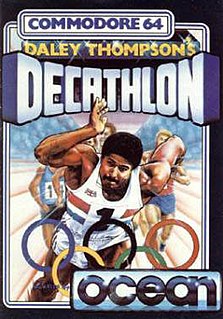
Daley Thompson's Decathlon is an Olympic-themed sports video game developed and released by Ocean Software in 1984. It was released in the wake of Daley Thompson's popularity following his gold medals in the decathlon at the 1980 and 1984 Olympic Games. The game is based on the gameplay format established by 1983 arcade game Track & Field.
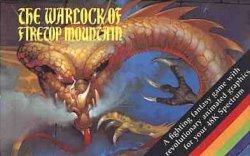
The Warlock of Firetop Mountain is an arcade adventure video game released by Crystal Computing in 1984 for the Sinclair ZX Spectrum home computer. It is loosely based on the adventure gamebook of the same name written by Steve Jackson and Ian Livingstone, and published by Puffin Books in 1982.

Thanatos is an action game developed and published by Durell Software in 1986 for the ZX Spectrum, Commodore 64 and Amstrad CPC.
Scetlander (later known as Lander Software was a software publisher which released titles for various 8- and 16-bit home computer systems in the 1980s and 1990s.

Ace is a combat flight simulator video game published for the Commodore 64, VIC-20, and Plus/4 in 1985 by Cascade Games. It was ported to the Amstrad CPC, Amstrad PCW, Amiga, and ZX Spectrum.
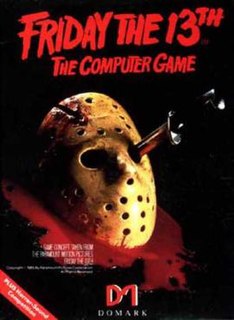
Friday the 13th: The Computer Game is the first game adaptation based on the films of the same name. It was released in 1986 by Domark for the Amstrad CPC, Commodore 64, and ZX Spectrum. The game was released on floppy diskette and cassette tape. The player's goal is to find and kill Jason, while making sure their friends or they themselves are not killed by Jason.

Nosferatu the Vampyre is an action game based on the film of the same name and runs on the Amstrad CPC, Commodore 64 and ZX Spectrum computers. It was developed by Design Design and published by Piranha Software in 1986.
